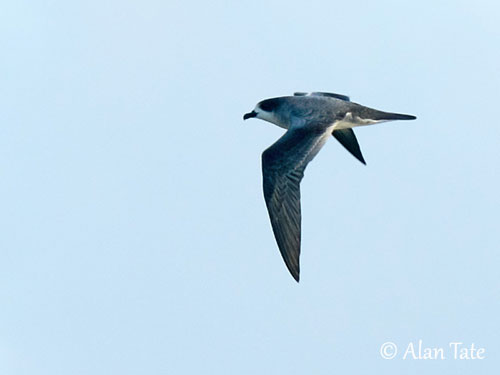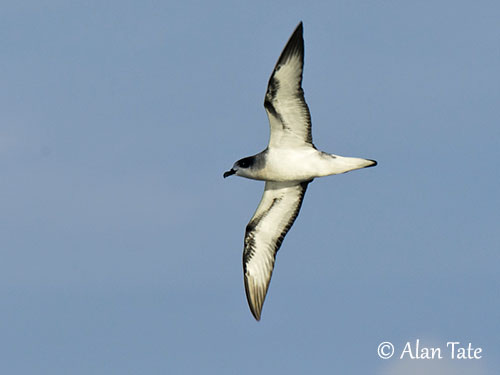
Fr: Pétrel de Barau
Ang: Barau’s Petrel
All: Barausturmvogel
Esp: Petrel de Barau
Ita: Petrello di Barau
Nd: Baraus Stormvogel
Sd: baraupetrell
Photographers:
Dubi Shapiro
Dubi Shapiro Photo Galleries & Dubi Shapiro's Pictures on IBC
Alan & Ann Tate
AA Bird Photography
Text by Nicole Bouglouan
Sources:
HANDBOOK OF THE BIRDS OF THE WORLD vol 1 by Josep del Hoyo-Andrew Elliot-Jordi Sargatal - Lynx Edicions - ISBN: 8487334105
The Birds of Africa: Volume VIII: The Malagasy Region: Madagascar, Seychelles, Comoros, Mascarenes - Par Roger Safford, Frank Hawkins – ISBN: 1408190494, 9781408190494- Editeur: A&C Black, 2013
Guide des Oiseaux de mer de Peter Harrison – Editeur: Broquet Lavoie - ISBN-10: 2890004090 – 448 pages
OISEAUX des ÎLES DE L’OCÉAN INDIEN De Ian Sinclair – Editeur: Penguin Random House South Africa, 2013 – ISBN: 1775840727, 9781775840725 – 263 pages
Life+ Pétrels - Pétrel de Barau
Wikipedia, the free encyclopaedia
Plan de Conservation du Pétrel de Barau
SEOR – Taille-vent ou Pétrel de Barau
Barau’s Petrel: history, biology and conservation of an endangered endemic petrel
Barau’s Petrel
Pterodroma baraui
Procellariiformes Order – Procellariidae Family
INTRODUCTION:
The Barau’s Petrel is part of the group of the « gadfly-petrels » named for their fast, waving flight. The name of this species pays tribute to the ornithologist Armand Barau. The Barau’s Petrel was first described in 1964, but it was known to local people prior to that.
This species breeds on the Island of Reunion in the Indian Ocean. It is present across the Indian Ocean from Reunion to W Australia and Indonesia during migration.
The Barau’s Petrel is pelagic and feeds at sea, usually on small fish, crustaceans and squid. It nests in colonies and the eggs are laid in burrows. The colonies are established at high elevations and far inland, and the burrows are dug in volcanic soil under the forest.
The Barau’s Petrel is classified as Endangered. It is threatened by introduced mammals (cats and rats) that take both eggs and chicks. A significant threat is caused by the light pollution involving the disorientation of the young birds that fall to the ground.
Conservation measures to reduce light pollution and control of feral cats near the colonies are on their way. The breeding colonies are fully protected since 2007.

DESCRIPTION OF THE BIRD:
Biometrics:
Length: 38 cm
Wingspan: 96 cm
Weight: 433 g
The Barau’s Petrel is a medium-sized petrel. The upperparts are dark greyish and the underparts are white.
On the upperparts, we can see pale grey fringes to the slate-grey feathers from hindneck to uppertail-coverts, scapulars and anterior base of upperwing. Rest of upperwing is darker, mostly dark grey to blackish, usually paler on greater coverts and base of secondaries and inner primaries. The typical “M” pattern extends across back and upperwing-coverts, but it is less conspicuous than in other species. The uppertail is dark grey.
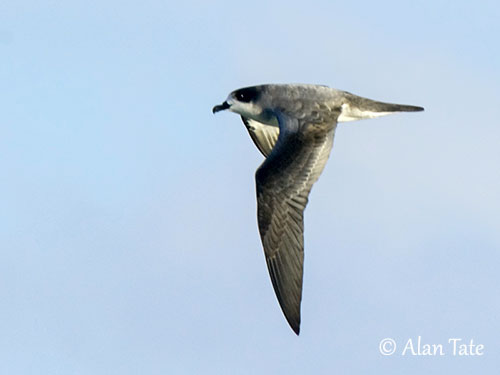
The underwing is white except a narrow, dark trailing edge and a blackish leading edge on carpal area, continuing as narrow dark bar across central underwing. The undertail is dark grey with whitish bases, but mostly white on outer rectrices.
On the head, the forehead has slightly mottled pattern with blackish-grey feathers showing broad white edges. This pattern may extend to the rear of the superciliary area. Crown and nape are blackish-grey, extending down around the eye and to upper ear-coverts, involving capped appearance. Lower face and sides of forehead are white, but a grey area on the neck sides forms a partial collar.
The bill is black. The eyes are dark brown. Legs and base of feet are pale pink, whereas rest of feet and outer toes are blackish.
The female has similar plumage but she is slightly smaller.
The juvenile resembles adults.
RANGE:
The Barau’s Petrel breeds only on the Island of Reunion in the Indian Ocean. However, this species also occurs from Reunion to W Australia and Indonesia outside of breeding season.

HABITAT:
The Barau’s Petrel is highly pelagic and forages offshore, although it can be seen sometimes over the continental shelf. Outside of breeding season, it forages mostly in warm surface temperatures, between W South Equatorial Current and E Equatorial Counter Current.
This species breeds in montane forest, between 2,200 and 2,900 metres of elevation. The burrows are usually excavated in cliffs and volcanic peaks.
CALLS AND SONGS: SOUNDS BY XENO-CANTO
The Barau’s Petrel is silent at sea, but at colonies, it gives typical “oaoou” followed by “kekekeke” often repeated two or three times. We can also hear a “pick-tek” derived from the previous ones.
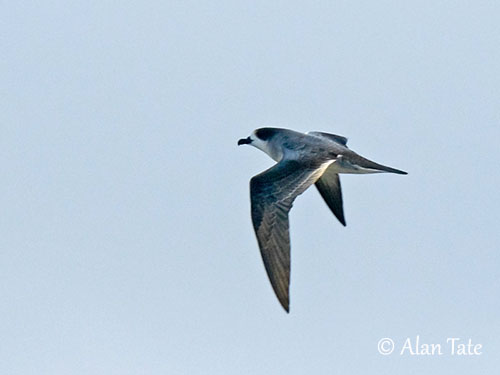
BEHAVIOUR IN THE WILD:
The Barau’s Petrel feeds on small fish, crustaceans and squid of 10 centimetres long. The prey are caught at sea surface by surface-seizing, dipping and surface-plunging.
It may forage alone or in small groups, often associated with Sooty Tern and shearwaters. From a recent study, it is suggested that young and adults consume different prey items, probably adapted to their respective needs.
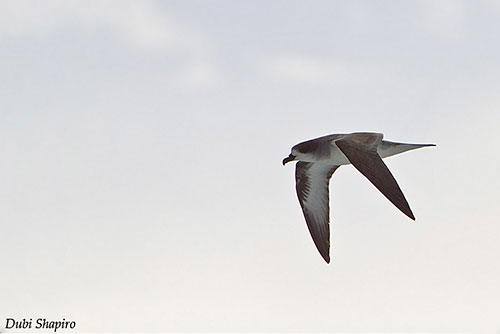
The Barau’s Petrel nests in burrows dug in earth, or in crevices or under rocks. The burrow is excavated by both mates and probably reused year after year. They perform a pre-laying exodus during which the male forages further from the colony, in waters with large chlorophyll concentration. It is often more active than the female, because it will take the first incubation shift, always longer than the others. They are colonial nesters.
The Barau’s Petrel may move up to 5,000 kilometres outside of breeding season. They leave the colonies in late March and reach the wintering areas by mid-April. The males return slightly earlier to the colonies, usually in September. Both sexes perform similar migration pattern.
The Barau’s Petrel is also named “taille-vent” from its spectacular flight involving low soaring close to the water surface followed by rapid ups and downs perpendicular to the waves.
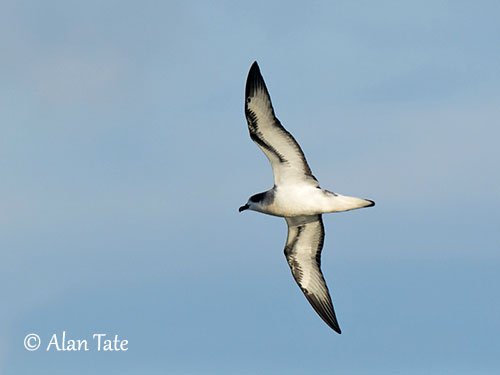
REPRODUCTION OF THIS SPECIES:
The breeding season starts in October/November. The Barau’s Petrel is a colonial nester. It nests in burrows, about 25 kilometres inland. The colonies are established on cliffs and steep slopes, between 2,200 and 2,900 metres of elevation, making the nesting sites inaccessible and naturally protected from intruders. These colonies are usually in upland cloud-forest with endemic shrubs of genera Erica and Sophora. The vegetation is dense and 4-5 metres high.
The burrow is excavated in thick humus layer and may reach in average 98-100 centimetres long, 19 centimetres width and 11 centimetres high. Sticks of Erica reunionensis (tree heathers) are used as nesting material. The largest colony contains up to 900 burrows on ridge and plateau area.
Unlike most petrel species that arrive at colonies by night, the Barau’s Petrel often arrives above the colonies in daylight, probably due to the inaccessibility of the sites.
The laying occurs in November and the chicks hatch in late December/early January. They fledge in mid-April. The eggs are not described, but this species probably lays a single, white egg like other petrels.
Both adults take turns during the incubation, alternating shifts with foraging trips of about 12-18 days. The incubation period lasts more or less 50 days. The young fledge about three months after hatching.
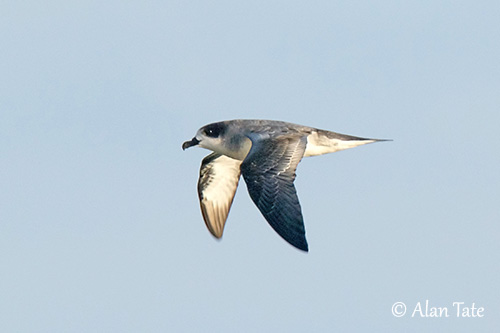
PROTECTION / THREATS / STATUS:
The Barau’s Petrel is a restricted range species during the breeding season. During the nesting period, they are threatened by predation by introduced cats and rats, and disturbance of colonies. They are attracted to artificial lights, mainly the young birds that suffer disorientation and fall to the ground where they can be killed as they are not able to reach the sea without help. This problem involves massive seasonal mortality, but rescue campaigns allow marking and recapturing of most birds.
The Barau’s Petrel is protected since 1989 and the colonies are in special reserve since 2001, within Reunion National Park.
The size of the population was roughly estimated to number 15,000 individuals in 1991 and 6,000/8,000 mature individuals with other colonies discovered in 2001.
The species is suspected to be undergoing a long-term decline, and the Barau’s Petrel is currently classified as Endangered.
